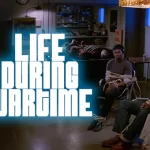**/**** Image A- Sound B
starring Kermit the Frog, Miss Piggy, Fozzie Bear, Gonzo
screenplay by Frank Oz and Tom Patchett & Jay Tarses
directed by Frank Oz
by Bill Chambers The third and final Muppet feature to which the dearly departed Jim Henson contributed, The Muppets Take Manhattan is a hodgepodge of terminally ’80s show tunes and ill-considered plotting that ransacks The Muppet Movie‘s basic premise–colourful nobodies seeking stardom–while gutting it of its thematic resonances, including the power of interracial harmony, i.e., “the Rainbow Connection.” What we’re left with is something that sparks but never ignites; The Muppets Take Manhattan is a Muppet film largely without Muppets save Kermit the Frog, and when you get right down to it, Kermit is only as interesting as his sparring partner. Like most leading men, he’s handsome but a bit of a blank slate.
Retooling the Muppet mythology once again, The Muppets Take Manhattan begins at a community college, where Kermit and co. are performing a self-scripted revue called “Manhattan Melodies.” The audience response is encouraging (it is indeed above-average for community-college students), but the Broadway producers to whom they subsequently pitch the show are considerably less receptive. Feeling like a burden to their green capitan, Kermit’s cuddly pals go their separate ways, leaving him to struggle alone in the Big Apple (he gets a job at a diner, working alongside rats), a curious screenwriting faux pas: this group doesn’t scatter, it swarms. Subsequent appearances by the likes of Gonzo and Rowlf the Dog are limited to vignettes until they return for the climactic reunion. A Muppet movie where Kermit and Fozzie aren’t palling around feels perverse, like a Hope-Crosby movie where they’re going down different roads.
Things get more subversive when Kermit is hit by a car on his way home from finally selling the play. The camera cranes up for a familiar bird’s-eye view of the accident, wherein we see Kermit’s writhing form; it’s not as disturbing as it sounds, but it gives you an idea of The Muppets Take Manhattan‘s essential joylessness. The picture recovers some wit after that (actually, immediately prior, when we see the contents of Miss Piggy’s purse: some lipstick, a hacksaw…), with an amnesia-suffering Kermit naming himself “Phil” and getting a job at an ad agency run by “Gil, Bill, and Jill.” (It’s the kind of simple wordplay gag this team does so well.) Yet most of what precedes this development is flat and vaguely depressing, and too much of what follows it is, even for the Muppets, fantastical in its illogic. How exactly does a company manage to mount a Broadway spectacle in the span of two weeks and sufficiently advertise it and rehearse it to perfection sans the star performer? I say spectacle, by the way, because the stage, at one point, expands to roughly the size of the Sistine Chapel for a wedding number in which Kermit and Piggy may or may not be married for real. Perhaps the entire third act is Kermit’s coma dream.
I almost forgot: the cameos. Many children from my generation were introduced to our parents’ idols via the line-up of guest stars on TV’s “The Muppet Show” and the Muppets’ first two cinematic outings, Movie (my earliest memory of James Coburn) and The Great Muppet Caper (ditto Peters Ustinov and Falk). The Muppets Take Manhattan‘s celeb line-up is typical of mid-Eighties pop-culture ubiquity: the folks who were everywhere are here as well, including Joan Rivers, Brooke Shields, Dabney Coleman, and Gregory Hines. It’s not their fault they further cheapen an undercooked effort, it’s just the way it is–and there just isn’t enough to make up for the picture’s shortfalls. No, not even the brilliant fantasy sequence that introduced the world to Muppet Babies, which is oodles more charming than the cartoon series it spawned. It may not sound like it but I’m one of the biggest Muppet/Henson fans around. True fans aren’t afraid to demand par.
THE DVD
Columbia TriStar’s DVD release of The Muppets Take Manhattan is strong. The image is presented two ways on a dual-layer disc: 1.85:1 anamorphic widescreen or standard 1.33:1, the latter a genuine pan-and-scan travesty. (The Muppet films were shot hard-matted in order to provide absolute boundaries for the puppeteers.) Both transfers are free of debris and sport vivid colours–in sharp contrast, I’m told, to The Muppet Movie‘s own DVD. Black level is superior in general. The 2.0 Dolby mono soundmix is a disappointment since I grew up with the songs in stereo on vinyl–or it would be if I liked the music more. An engaging 15-minute interview with Henson circa 1984 is needlessly divvied up into fourteen individually-titled segments (“Directing vs. Acting,” “Kermit & Jim,” “Magic,” “Expanding the Character’s Role,” “Kermit Comes Alive,” “Experimenting,” “Filming in New York City,” “The Art of Puppetry,” “The Kitchen Scene,” “Director Frank Oz,” “Singing in Character,” “Kermit’s Voice,” “A Team Effort,” “Cameo Roles”), while the remaining bonus material is not nearly as prized: three “Muppetisms” (juvenile, pseudo-inspirational PSAs), plus trailers for The Adventures of Elmo in Grouchland, Buddy, and Muppets from Space. Nope, The Muppets Take Manhattan‘s own preview didn’t make the cut.
94 minutes; G; 1.85:1 (16×9-enhanced); English DD 2.0 (Mono), French DD 2.0 (Mono), Spanish DD 2.0 (Mono), Portuguese DD 2.0 (Mono); CC; English, French, Spanish, Portuguese, Chinese, Korean, Thai subtitles; DVD-9; Region One; Columbia TriStar





